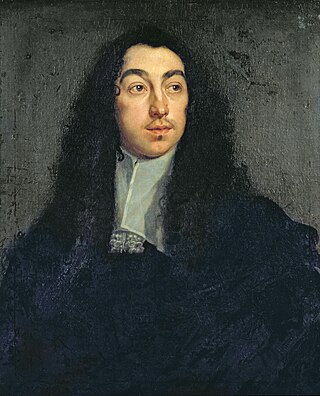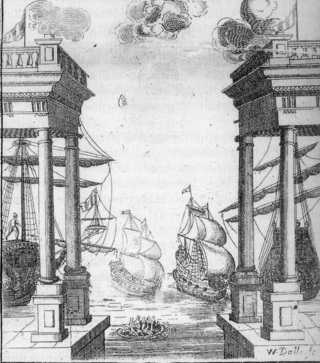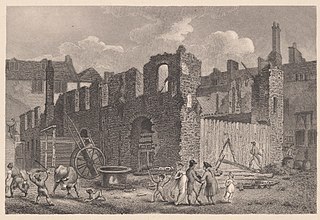
Sir William Davenant, also spelled D'Avenant, was an English poet and playwright. Along with Thomas Killigrew, Davenant was one of the rare figures in English Renaissance theatre whose career spanned both the Caroline and Restoration eras and who was active both before and after the English Civil War and during the Interregnum.
This article contains information about the literary events and publications of 1660.
This article contains information about the literary events and publications of 1656.

Thomas Patrick Betterton, the leading male actor and theatre manager during Restoration England, son of an under-cook to King Charles I, was born in London.
The history of opera in the English language commences in the 17th century.

Matthew Locke was an English Baroque composer and music theorist.

The Restoration spectacular was a type of theatre production of the late 17th-century Restoration period, defined by the amount of money, time, sets, and performers it required to be produced. Productions attracted audiences with elaborate action, acrobatics, dance, costume, scenery, illusionistic painting, trapdoors, and fireworks. Although they were popular with contemporary audiences, spectaculars have earned a reputation from theatre historians as vulgar in contrast to the witty Restoration drama.

Rutland House was the name of at least two London houses occupied by the Earls and Dukes of Rutland. That on Aldersgate Street was leased by playwright Sir William Davenant, who converted a room of it into a private theatre in the 1650s. That in Knightsbridge was a six-acre site until its demolition in the 1830s.
Henry Cooke commonly known as Captain Cooke, was an English composer, choirmaster and singer. He was a boy chorister in the Chapel Royal and by the outbreak of the English Civil War was a Gentleman of the Chapel Royal. He joined the Royalist cause, in the service of which he rose to the rank of captain. With the Restoration of Charles II he returned to the Chapel Royal as Master of the Children and was responsible for the rebuilding of the chapel and the introduction of instrumental music into the services. The choristers in his charge included his successor and eventual son-in-law Pelham Humfrey, as well as Henry Purcell and John Blow.

The Dorset Garden Theatre in London, built in 1671, was in its early years also known as the Duke of York's Theatre, or the Duke's Theatre. In 1685, King Charles II died and his brother, the Duke of York, was crowned as James II. When the Duke became King, the theatre became the Queen's Theatre in 1685, referring to James' second wife, Mary of Modena. The name remained when William III and Mary II came to the throne in 1689.

The Cockpit was a theatre in London, operating from 1616 to around 1665. It was the first theatre to be located near Drury Lane. After damage in 1617, it was named The Phoenix.

Lisle's Tennis Court was a building off Portugal Street in Lincoln's Inn Fields in London. Originally built as a real tennis court, it was used as a playhouse during two periods, 1661–1674 and 1695–1705. During the early period, the theatre was called Lincoln's Inn Fields Playhouse, also known as The Duke's Playhouse, The New Theatre or The Opera. The building was demolished and replaced by a purpose-built theatre for a third period, 1714–1728. The tennis court theatre was the first public playhouse in London to feature the moveable scenery that would become a standard feature of Restoration theatres.

Gibbon's Tennis Court was a building off Vere Street and Clare Market, near Lincoln's Inn Fields in London, England. Originally built as a real tennis court, it was used as a playhouse from 1660 to 1663, shortly after the English Restoration. As a theatre, it has been variously called the "Theatre Royal, Vere Street", the "Vere Street Theatre", or simply "The Theatre". It was the first permanent home for Thomas Killigrew's King's Company and was the stage for some of the earliest appearances by professional actresses.
Events from the year 1656 in England.

The Duke's Company was a theatre company chartered by King Charles II at the start of the Restoration era, 1660. Sir William Davenant was manager of the company under the patronage of Prince James, Duke of York. During that period, theatres began to flourish again after they had been closed from the restrictions throughout the English Civil War and the Interregnum. The Duke's Company existed from 1660 to 1682, when it merged with the King's Company to form the United Company.
John Rhodes was a theatrical figure of the early and middle seventeenth century. He rose to a brief prominence in 1660 when the London theatres re-opened at the start of the English Restoration era.
George Jolly, or Joliffe was an actor, an early actor-manager and a theatre impresario of the middle seventeenth century. He was "an experienced, courageous, and obstinate actor-manager" who proved a persistent rival for the main theatrical figures of Restoration theatre, Sir William Davenant and Thomas Killigrew.
The Cruelty of the Spaniards in Peru was an innovative 1658 theatrical presentation, a hybrid entertainment or masque or "operatic show", written and produced by Sir William Davenant. The music was composed by Matthew Locke.
The History of Sir Francis Drake was a hybrid theatrical entertainment, a masque or "operatic tableau" with an English libretto written by Sir William Davenant and music by Matthew Locke. The masque was most likely first performed in 1659 and produced by Davenant. As with his earlier The Siege of Rhodes (1656) and The Cruelty of the Spaniards in Peru (1658), Davenant cast The History of Sir Francis Drake as a musical drama to avoid the Puritan prohibition of stage plays during the English Commonwealth era. The three Davenant works were important in the evolution of English opera and musical theatre, and heralded the coming revival of drama with the Restoration of 1660.

Henry Harris was an English stage actor and theatre manager. Initially a painter he was a founder member of the new Duke's Company in 1660 following the Restoration which established itself at the old Salisbury Court Theatre before moving to the new Lincoln's Inn Fields Theatre shortly afterwards. Due to his background Harris may have been a set designer and painter during his early years with the company. However, by 1661 he was acting, and his first recorded role was in William Davenant's The Siege of Rhodes that summer. He quickly established himself as the second actor in the troupe after Thomas Betterton.









